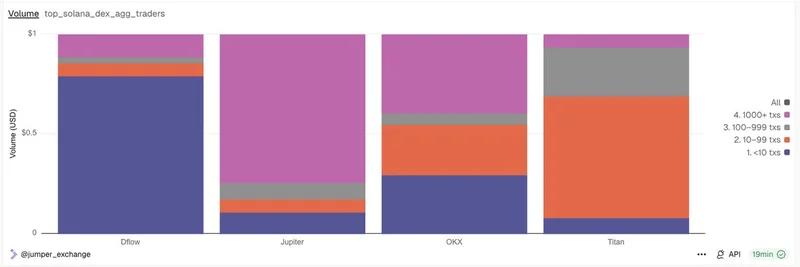In the fast-paced world of blockchain trading, understanding how volumes break down across different platforms can give you a real edge. A recent thread from Octave, Data Lead at Jumper Exchange, dives deep into trader patterns on Solana's top DEX aggregators: Jupiter, DFlow, and Titan. By comparing these to EVM-based aggregators, we get fresh insights into how Solana's ecosystem is evolving—especially when it comes to memecoin trading, which is right up our alley here at Meme Insider.
Let's start with the big picture on trader activity. On Jupiter Exchange, more than 80% of the trading volume comes from addresses that have racked up over 1,000 transactions. These high-activity wallets make up less than 10% of all users, pointing to heavy involvement from bots or market makers. It's like the platform is powered by automated pros rather than everyday traders.
In contrast, DFlow flips the script. About 80% of its volume is from users with fewer than 10 transactions. While there are some high-activity accounts, they seem tied to things like arbitrage or portfolio rebalancing rather than constant bot trading. Then there's Titan Exchange, where volume is mostly from wallets with 10 to 99 transactions—a middle ground that might include both humans and semi-automated setups.
When you stack this up against EVM aggregators like those on Ethereum, the patterns look more balanced overall. EVM platforms show activity spread across user segments, and interestingly, they resemble Titan's profile more than Jupiter's. CowSwap, for example, has fewer transactions per user but echoes Titan in its trader mix.
Interpreting these trends, Jupiter stands out for its bot-heavy vibe—some top addresses hit over 20,000 transactions in 30 days, which is way beyond human capability. DFlow feels more retail-oriented with its low-activity dominance, while Titan offers a blend. Benchmarking against EVM norms, Titan and DFlow (minus their top traders) align closer than Jupiter does.
Shifting to trade sizes, DFlow leads with deals between $10K and $100K, Titan focuses on $1K to $10K trades, and Jupiter has a more even split across medium and large sizes. On the EVM side, aggregators are pretty uniform, except for 0x Project favoring smaller trades and CowSwap going big. A key difference: large trades dominate EVM volume (60-85%), but on Solana, they're under 10%. This highlights Solana's appeal for quicker, smaller swaps, possibly due to its low fees and high speed.
Finally, let's talk tokens—and this is where it ties back to memes. On Solana, Jupiter, and DFlow, the volume is mostly stables, SOL, and related assets. Memecoins? They're just a small slice, under 15% now. That's down from about 30% 18 months ago, showing Solana's DEX scene is maturing. It's trending toward EVM levels, where memecoin volume hovers at 5-10%. For meme token enthusiasts, this means the wild days of pump-and-dump dominance might be giving way to more stable, utility-focused trading.
This data, pulled from Dune Analytics, underscores how Solana is growing up. If you're building or trading in the meme space, keep an eye on these shifts—they could signal where the next opportunities lie. For more on meme tokens and blockchain trends, stick with Meme Insider.




